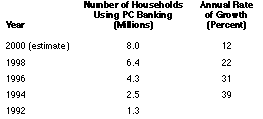Online Banking: Catch the Next Wave MacroMonitor Marketing Report Vol. IV, No. 5 January 2000
Online banking has been available for more than a decade. Full Internet access to a customer's entire range of financial accounts is now readily available. Yet the interest in online banking has not quite caught on with personal computer (PC) users in the same way that other Internet activities have. In the early days of the Internet, many analysts thought that online banking would explode. But news, information, entertainment, and retail sites continue to dominate the top Web rankings in terms of unique visitors. The rate of growth in online banking already appears to be slowing down.
PC Banking Users and Market Growth Rate

The MacroMonitor estimates 6.4 million PC-banking user households in 1998. An additional 1.3 million households report that they had used PC banking in the past, but no longer use the service (20% of the current PC-banking user base). More than a million households (17% of the PC-banking user base) currently have PC banking but do not expect to continue to use it in the future. These two numbers support the possibility that the growth rate in the PC-banking user base will continue to decline. Many PC-banking users may not be totally satisfied with the online banking experience, and for some reason the experience did not meet their needs.
How can financial institutions raise the momentum of the online banking market? Attracting and keeping the next layer of potential users remains a challenge. This MacroMonitor report compares the demographic and attitudinal profiles of current PC-banking users with those of potential users. This differentiation provides a critical starting point for online financial marketers in developing or revising marketing strategies and product features to meet the needs of the next wave of online banking customers. Only then can PC banking have a chance of eventually penetrating the mainstream market.
For the first wave of users, the convenience and accessibility of financial information outweigh the need for personalized contact and service from financial personnel. The next wave of online users will require more handholding in managing household finances online. As the PC eventually becomes as ubiquitous as the telephone and the television in U.S. households, the trend toward more mainstream PC banking users will continue. But to penetrate the mainstream market, banks will have to take specific customer-focused steps. The learning curve needs to be short and the process simple and straightforward, such that after one visit the user can be an "expert." Without a proactive strategy that would make online banking service more user-friendly, these potential users will not likely ever become actual PC-banking users.

The MacroMonitor estimates 6.4 million PC-banking user households in 1998. An additional 1.3 million households report that they had used PC banking in the past, but no longer use the service (20% of the current PC-banking user base). More than a million households (17% of the PC-banking user base) currently have PC banking but do not expect to continue to use it in the future. These two numbers support the possibility that the growth rate in the PC-banking user base will continue to decline. Many PC-banking users may not be totally satisfied with the online banking experience, and for some reason the experience did not meet their needs.
How can financial institutions raise the momentum of the online banking market? Attracting and keeping the next layer of potential users remains a challenge. This MacroMonitor report compares the demographic and attitudinal profiles of current PC-banking users with those of potential users. This differentiation provides a critical starting point for online financial marketers in developing or revising marketing strategies and product features to meet the needs of the next wave of online banking customers. Only then can PC banking have a chance of eventually penetrating the mainstream market.
For the first wave of users, the convenience and accessibility of financial information outweigh the need for personalized contact and service from financial personnel. The next wave of online users will require more handholding in managing household finances online. As the PC eventually becomes as ubiquitous as the telephone and the television in U.S. households, the trend toward more mainstream PC banking users will continue. But to penetrate the mainstream market, banks will have to take specific customer-focused steps. The learning curve needs to be short and the process simple and straightforward, such that after one visit the user can be an "expert." Without a proactive strategy that would make online banking service more user-friendly, these potential users will not likely ever become actual PC-banking users.